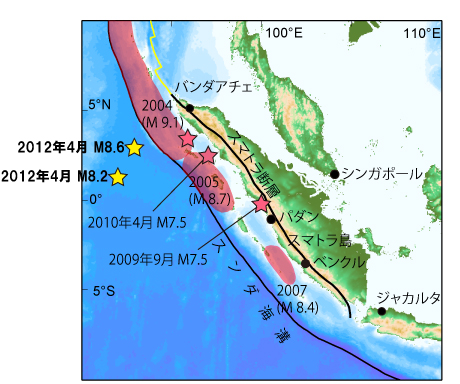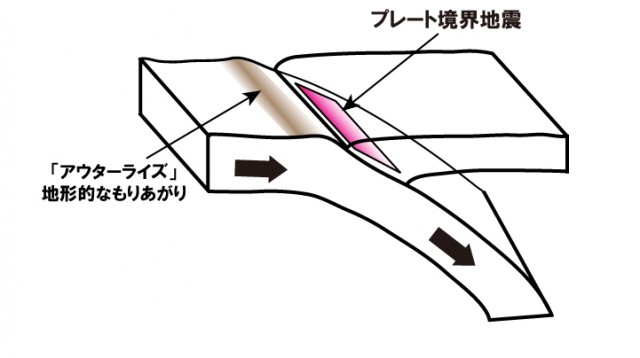Launched: 16th April 2012
2012 Off the West Coast of Northern Sumatra Earthquake (11th April 2012)
14:38 11th April, 2012 (local time/ 17:38 JST/8:38 UTC), M8.6 earthquake struck off the west coast of the northern Indonesian island of Sumatra. Tsunami alert was issued to countries in Indian Ocean. According to JMA, no tsunami is expected in Japan
[Basic Information](USGS)
- Location of hypocenter: 2.311°N, 93.063°E, 22.9 km depth
- Magnitude: Mw 8.6
- Related plates: Indo-Australian plate, Eurasian plate
- Type of focal mechanism: Strike-slip fault
[Tectonic backgrounds]
Sumatra Island is located in the plate boundary where Australian plate is subducting under Eurasian plate by 60-65mm annually, and is one of the most seismically active areas in the world. Past major earthquakes in this area are: the Sumatra Earthquake in 2004(M9.1), with death toll of more than 200,000 people, and the M8.7 earthquake which struck 3 month after this Sumatra Earthquake. (fig.1)
[The characteristics of this earthquake]
This earthquake is occurring about 100km to the southwest of the place where M9.1 earthquake occurred in 2004. The location of the hypocenter is off the west coast of the plate boundary, and is not an interplate earthquake like the 2011 Tohoku Earthquake or the Sumatra earthquake in 2004.
This kind of interplate earthquakes is generally called outer-rise earthquake because of the location where it occurs. “Outer-rise” (or “Outer trench swell”) is a small ridge on the seafloor near the ocean trench. This small ridge is considered to be formed because the subducting plate starts bending just before the ocean trench. When the hypocenter is shallow, often outer-rise earthquakes show normal fault mechanisms because of the tension caused by this bending (fig.2).
It is often said that the possibility of normal-fault type outer-rise earthquake may increase, when interplate massive earthquake occurs. Despite this background, this earthquake happened to have a strike-slip fault mechanism, which is different from the usual outer-rise earthquake (i.e., normal fault). The landform or the structure may have influenced, but it is not well known why it was a strike-slip fault.
Therefore, wether or not this earthquake should be called “outer-rise earthquake” remains to be discussed.
In case of a strike-slip fault, the possibility of emerging tsunami is lower compared to the normal fault and reverse fault. Therefore, the mechanism of strike-slip fault may be a part of the reason of no major tsunami despite the large magnitude of M8.6.
2 hours later at 16:43 (local time, 19:43 Japan time), M8.2 earthquake occurred on southwest of the first earthquake. The magnitude is relatively big to call it an aftershock, but the mechanism is very similar with the one occurred before. In addition, M7.2 earthquake struck on 10th January 2012, just near the M8.6 earthquake on 11th, and may be considered to be a foreshock.
It is difficult to quantitatively examine, but it is natural to think that this earthquake was caused by the influence (change in stress state inside the plate) of the 2004 Sumatra earthquake (M9.1). In Japan, the possibility of outer-rise earthquake has been suggested since the M9 2011 Tohoku earthquake. It is necessary to be prepared for an outer-rise earthquake of the Tohoku coast, taking granted that its impact may prevail for tens of years.
Some examples of outer-rise earthquakes are:
- 1933 Sanriku Earthquake: Occured 37years after the Meiji Sanriku Earthquake in 1896. Caused a devastating tsunami.
- M8.1 earthquake. 2months after Krile Islands Earthquake in November 2006
[Waveform observed by J-array]
2012 OFF THE WEST COAST OF NORTHERN SUMATRA(Earthquake and Volcano Information Center)
http://wwweic.eri.u-tokyo.ac.jp/topics/20120411/
(Associate Professor. Tsuruoka)
LINKS


